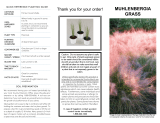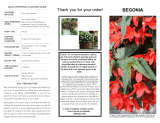Page is loading ...

MATURE
HEIGHT / SPREAD
CONTAINER SIZE
*Image on cover is representative of the type of plant(s) in this offer and
not necessarily indicative of actual size or color for the included variety.
SNAKE PLANT
Thank you for your order!
Caution: Do not assume any plant is safe
to eat. Only parts of plants expressly grown
to be eaten should be considered edible.
As with any product that is not food, care
should be taken to make sure that small
children and pets do not ingest any part of
a plant that is not expressly grown to be
eaten.
Unless specifically stated, this product is
intended for ornamental horticultural use
only and is not intended for consumption
or ingestion by humans or pets. Most
plants are harmless but some contain toxic
substances which can cause adverse health
effects. Furthermore, some individuals and
some animals are sensitive or allergic to
certain plants and precautions should be
taken to limit or avoid physical contact with
particular plants. Some plants have thorns
or spines that can be painful if handled.
In case of ingestion contact a poison
control center immediately.
1-800-222-1222
LIGHT/SUN
EXPOSURE
USDA
HARDINESS
ZONES
PLANTING
DISTANCE
IN-GROUND
18 to 36 inches tall with a 12 to 18
inch spread.
12 months.
Makes an excellent houseplant.
Great for decorative containers.
Dramatic upright. foliage.
TIME TO REACH
MATURITY
FACTS OF NOTE
PLANT TYPE
Annual/Tropical.
One plant per 12-inch or larger
container.
QUICK REFERENCE PLANTING GUIDE
At least 12 inches apart.
Bright indirect light.
Not winter hardy.
We recommend planting in a
container so you can move the
plant indoors before the first frost.

PLANTING INSTRUCTIONS
During the growing season, allow the top inch of soil
to dry out between each watering. Water thoroughly
until the soil is moist and excess water drains from the
bottom of the pot. Avoid over watering or pouring
water on the leaves.
FEEDING
GROWING OUTDOORS
Snake plants may be grown outdoors during the
warm months, and should be moved indoors before
the temperature drops below 50°F.
When you bring your plant indoors for winter, select
a room with a sunny window. Water sparingly over
winter, removing any dead or unsightly growth as
needed.
In spring when temperatures begin to rise, ease the
plant back into a full watering schedule and move it
back outdoors for the summer.
CONTINUING CARE (Continued)
A
We strongly recommend planting in a container in order
to properly protect your plant from winter damage. Use
the following instructions as a guide for container planting.
Important: Thoroughly hydrate the plant by submersing
the root zone in a container of water for 10 minutes while
you prepare for planting.
B
Water well and, if necessary, adjust the plant so it is
upright and add additional soil if needed, Check to
be sure the plant is not planted too deeply. If it is,
raise the plant carefully and re-firm the soil.
C
Once the plant is properly positioned in the pot,
begin filling the pot with soil. Work the soil around
the root ball with your hands, firming the soil
around the plant with your fingers. When the hole is
filled, tamp the soil to remove any air pockets.
Fill the container with soil to within 4 inches of the
top. Remove the pot and prepare the root ball for
planting by gently disturbing the surface roots with
your fingers, fork, or gardening tool and pruning
any damaged roots. Dig a hole in the soil to insert
the lower part of the root ball.
Snake Plants adapt well to indoor environments and
can be kept as houseplants year-round. Select a
room with a sunny window where the temperature
stays between 65-75°F. Wipe the leaves with a
damp cloth as needed if they become dusty.
Apply a 2-4 inch layer of shredded bark, compost,
leaves, straw or other organic matter around your
plants to promote moisture retention, maintain even
soil temperatures and discourage weed growth.
Replenish the mulch as needed.
Keep the area around your plants free of weeds.
Weeds compete with surrounding plants for food,
water and light. Walk around the garden periodically
and pull weeds, including the roots, as soon as you
see them.
GROWING INDOORS WATERINGMULCHINGWEEDING
CONTINUING CARE
OUT OF THE BOX
Your plants have been shipped to you in pots. We urge
you to remove them from the shipping box and plant
them as soon as possible. Should planting be delayed due
to weather or other unforeseen circumstances, roll the
plastic bag down around each plant and place them near
a bright window or other sunny location. Keep them well-
watered in their pots until permanently planted. Once
planted, they begin setting roots and, as the weather
warms, begin showing new growth. Please plant as soon
as possible, provide reasonable care and be patient.
SNAKE PLANT
The foliage on potted plants may appear slightly wilted or
yellow upon arrival. This is due to the stress of shipping
and is usually nothing to worry about. Water the plant
thoroughly, place it in a shady location and remove any
foliage that does not recover.
SOIL PREPARATION
SHIPPED AS SHOWN
We recommend having your soil tested periodically by
your local County Extension Office (www.nifa.usda.gov/
extension or by calling 1-800-333-4636). A soil test can
determine if your soil needs any amendments to enhance
the growth and performance of your plants.
Ideal garden soil is easy to dig in and drains well while still
holding the nutrients and water vital to plant growth. To
prepare a bed for in-ground planting, spade or till the soil
to a depth of roughly 12-18 inches. Next, spread a 2-4 inch
layer of organic matter such as compost, shredded leaves
or peat moss over the soil and mix well.
Feed your plants once every 2-3 weeks during the
growing season with a water soluble fertilizer
.
Discontinue feeding after September 1st so your
plants can prepare for winter. Resume fertilizing
when new growth appears in the spring.
/







